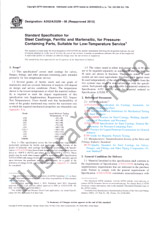Potřebujeme váš souhlas k využití jednotlivých dat, aby se vám mimo jiné mohly ukazovat informace týkající se vašich zájmů. Souhlas udělíte kliknutím na tlačítko „OK“.
ASTM E3042-16
Standard Practice for Process Step to Inactivate Rodent Retrovirus with Triton X-100 Treatment
Přeložit název
NORMA vydána dne 1.9.2016
Informace o normě:
Označení normy: ASTM E3042-16
Poznámka: NEPLATNÁ
Datum vydání normy: 1.9.2016
Kód zboží: NS-650888
Počet stran: 4
Přibližná hmotnost: 12 g (0.03 liber)
Země: Americká technická norma
Kategorie: Technické normy ASTM
Kategorie - podobné normy:
Anotace textu normy ASTM E3042-16 :
Keywords:
biological pharmaceutical drug substance, biopharmaceutical manufacturing, detergent inactivation, enveloped virus, IgG Fc fusion protein, log10 reduction value, modular viral clearance, monoclonal antibody, recombinant protein, retrovirus, Triton X-100, viral clearance, viral inactivation,, ICS Number Code 07.100.01 (Microbiology in general)
Doplňující informace
| Significance and Use |
|
3.1 Rodent-derived cell lines are widely used in the production of biopharmaceutical drugs such as mAbs and Fc fusion proteins. These cell lines have been shown to contain genes encoding endogenous retroviral-like particles or endogenous retrovirus. Despite the lack of evidence for an association between such rodent retroviruses and disease in humans, the potential contamination of human therapeutics raises safety concerns for biopharmaceutical drugs. Additionally, adventitious agents such as viruses can be introduced into a biopharmaceutical drug substance manufacturing process from other sources, and potential safety issues can be attributed to these potential unknowns. For these reasons, effective viral clearance is an essential aspect of an integrated approach combining safety testing and process characterization which ensures virus safety for biopharmaceutical drug products made using rodent cell lines. 3.2 Solvent/detergent inactivation has been widely used for decades to inactivate enveloped viruses in blood plasma derived biopharmaceutical therapies (1-3).3 Solvent/detergent systems using the detergents Triton X-100 or Polysorbate 80 along with the organic solvent tri(n-butyl)phosphate (TNBP) have been used to inactivate enveloped viruses by disrupting the viral envelope thereby reducing the ability of the enveloped virus to attach to and then infect the host cell (4 and 5). 3.3 Most manufacturers of mAbs, recombinant proteins, and Fc fusion proteins have focused on viral inactivation methods using the detergent Triton X-100 or Polysorbate 80 in the absence of TNBP (6), which can interfere with subsequent bioprocessing steps. The ability of the detergents alone to inactivate retroviruses has been demonstrated in monoclonal antibodies produced in rodent-derived cell lines (6-9). At a 2011 workshop devoted to viral clearance steps used in bioprocessing (7), investigators from one firm showed incubation with 0.2 % Triton X-100 for 60 min of hold time at ambient temperature inactivated >5 log10 of X-MuLV across four separate mAbs in cell culture matrices. 3.3.1 At the same 2011 workshop 3.4 Quertinmont (8) demonstrated that DNA level, total protein concentration, and lipid content (exceeding 1000 µg/mL) in a 0.45 % (w/v) Triton X-100 detergent inactivation step using HCCF were not statistically significant to the detection of MuLV virus following 60 minutes of inactivation using both monoclonal antibodies and Fc fusion proteins. Additionally, three Design of Experiment (DOE) robustness studies were carried out for three separate molecules varying biological drug concentration, total protein concentration, temperature, and Triton X-100 concentration. These studies demonstrated effective viral inactivation when Triton X-100 concentration is ≥0.2 %, temperature is between 15–25°C, and hold time is ≥60 minutes in HCCF. 3.5 Blumel and Tounekti (9) showed complete inactivation of MuLV across 4 mAbs [2 IgGs and 2 immunoglobulin M (IgMs)] for all time points (0, 5, 30, and 60 min) using 1.0 % Triton X-100 for a 60-minute hold time. The average log reduction factor (LRF) for these 15 studies was ≥ 3.89 log3.6 The extent of this retroviral inactivation could be dependent on certain reaction parameters including clarification, Triton X-100 concentration, hold time, pH, and inactivation temperature. However, managing parameters that give robust and effective retrovirus inactivation as specified by this practice, in conjunction with other clearance unit operations, can assure effective retroviral inactivation. 3.7 This practice incorporates parameters that give effective retrovirus inactivation, which can be used as modular validation of the viral clearance process for the specified viruses. |
| 1. Scope |
|
1.1 This practice assures effective inactivation of ≥4 log1.2 The parameters specified for this practice are clarification, Triton X-100 detergent concentration, hold time, pH, and inactivation temperature. 1.3 This practice can be used in conjunction with other clearance or inactivation unit operations that are orthogonal to this inactivation mechanism to achieve sufficient total process clearance or inactivation of rodent retrovirus. 1.4 This detergent inactivation step is performed on a clarified, cell-free intermediate of the monoclonal antibody or IgG Fc fusion protein. 1.5 The values stated in SI units are to be regarded as standard. No other units of measurement are included in this standard. 1.6 This standard does not purport to address all of the safety concerns, if any, associated with its use. It is the responsibility of the user of this standard to establish appropriate safety and health practices and determine the applicability of regulatory limitations prior to use. |
Doporučujeme:
Aktualizace technických norem
Chcete mít jistotu, že používáte pouze platné technické normy?
Nabízíme Vám řešení, které Vám zajistí měsíční přehled o aktuálnosti norem, které používáte.
Chcete vědět více informací? Podívejte se na tuto stránku.




 Cookies
Cookies
